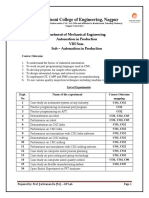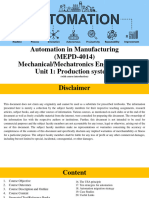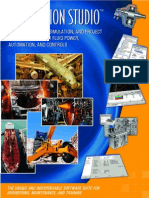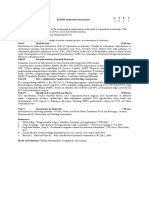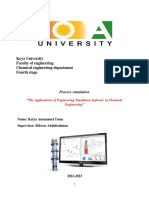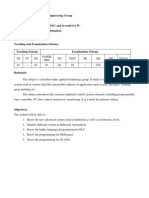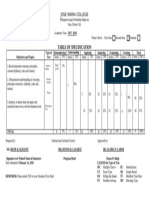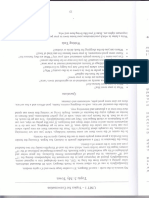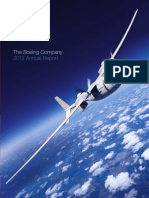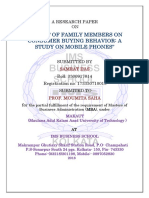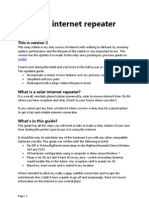Api I C1
Api I C1
Uploaded by
mihai37Copyright:
Available Formats
Api I C1
Api I C1
Uploaded by
mihai37Original Description:
Original Title
Copyright
Available Formats
Share this document
Did you find this document useful?
Is this content inappropriate?
Copyright:
Available Formats
Api I C1
Api I C1
Uploaded by
mihai37Copyright:
Available Formats
IST / DEEC / API
Industrial Automation
(Automao de Processos Industriais)
http://users.isr.ist.utl.pt/~jag/courses/api1112/api1112.html
Slides 2010/2011 Prof. Paulo Jorge Oliveira Rev. 2011/2012 Prof. Jos Gaspar
Page 1
IST / DEEC / API
A steam engine built to James Watt's patent in 1848 at Freiberg in Germany [wikipedia]
Page 2
IST / DEEC / API
Microcontrollers
Computer + IO
PLC
Many options for controlling real world devices! Why PLCs?
Page 3
Arduino
National Instruments AD/DA
Premium P57
IST / DEEC / API
Page 4
IST / DEEC / API
Industrial Automation
Objectives:
Analysis of systems for industrial automation. Methodologies for the implementation of solutions in industrial automation. Programming languages of PLCs (Programmable Logic Controllers). CAD/CAM and Computerized Numerical Controlled machines. Discrete Event Systems Modeling. Supervision of Processes in Industrial Automation.
Page 5
IST / DEEC / API
Industrial Automation
Program at a glance:
1. Introduction to Automation [1 week]
Introduction to components and methodologies.
5. CAD/CAM and CNC Machines [1 week]
Types of Computerized Numerical Controlled machines. Interpolation of trajectories. Flexible fabrication cells.
6. Discrete Event Systems [1 week]
Modeling of discrete event systems (DESs). Automata. Petri networks. State and dynamics of PNs.
2. Introduction to PLCs [2 weeks]
Components of Programmable Logic Controllers (PLCs). Architecture, functional structure, IO.
7. Analysis of DESs [2 weeks]
Properties of DESs. Methodologies for the analysis: reachability graph and matricial equation.
3. PLCs Programming Languages [2w]
Standard languages (IEC-1131-3): Ladder Diagram; Instruction List and Structured Text.
8. DESs and Industrial Automation [1week]
Relations GRAFCET / Petri networks. Analysis of industrial automation solutions as DESs.
4. GRAFCET (Sequential Function Chart) [1 week]
Norm, elements of the language, modelling.
9. Supervision of Industrial Processes [2w]
Methodologies for supervision. SCADA. Synthesis based on invariants. Examples of application.
Page 6
IST / DEEC / API
Industrial Automation
Assessment and grading:
2 Preliminary laboratory assignments - training purposes (0% of the final grade).
2 Laboratory assignments (20%+20% of the final grade). Groups of 3 students. 1 Seminar (20% of the final grade). Topics to be selected with each group. Exams (40% of the final grade). Two written. Upon student choice, the second exam can be oral. Minimum grade: 9.0/20.0 val. in each component.
Extra 1 (one) valor for students attending more than 50% of recitations.
Page 7
IST / DEEC / API
Schedule (laboratories & exam):
Lab. registration 1st preliminary lab. 2nd preliminary lab. 1st lab. assignment 2nd lab. assignment 3rd lab. assignment Exams First week 1 week 1 week 4 weeks 4 weeks 0.5h seminar 3h Fenix 14/09/2011 26-30/09/2011 03-07/10/2011 10/10-04/11/2011 07/11-02/12/2011 One date >= week 9 9Jan, 30Jan 2012
Page 8
Important: define the students representative
IST / DEEC / API
Industrial Automation
Schedule (according to IST-GOP):
Recitation classes Monday Friday 11.00 h 12.30h Ea5 11.00 h 12.30h Ea4
Lab. Classes (once per week) Monday Friday 09.30h 11.00h L1 LSDC4 (room 5.21) 09.30h 11.00h L2 LSDC4 (room 5.21)
Groups registration for the Laboratory By September 25th 2009 with the students representatives.
Page 9
IST / DEEC / API
Industrial Automation
Bibliography:
Automating Manufacturing Systems with PLCs, Hugh Jack (online version available).
Peterson, James L., "Petri Net Theory and the Modeling of Systems", Prentice-Hall,1981. Modeling and Control of Discrete-event Dynamic Systems with Petri Nets and other Tools, Branislav Hruz and MengChu Zhou, 2007. New reference --- secondary-- Programmable Logic Controllers, Frank D. Petruzella, McGraw-Hill, 1996. Petri Nets and GRAFCET: Tools for Modeling Discrete Event Systems, R. DAVID, H. ALLA, New York : PRENTICE HALL Editions, 1992. Computer Control of Manufacturing Systems, Yoram Koren, McGraw Hill, 1986. Cassandras, Christos G., "Discrete Event Systems - Modeling and Performance Analysis", Aksen Associates, 1993. Moody, J. e Antsaklis, Supervisory Control of Discrete Event Systems, Kluwer Academic Publishers, 1998. Page 10
IST / DEEC / API
Industrial Automation
(Automao de Processos Industriais)
Introduction to Automation
http://www.isr.ist.utl.pt/~jag/aulas/api1112/api1112.html
Slides 2010/2011, Prof. Paulo Jorge Oliveira Rev. 2011/2012, Prof. Jos Gaspar
Page 11
IST / DEEC / API
Robot
Ctrl Actuator Sensor
+Robot
+ ...
+ Global Controller
= Automated Industrial Process
The subject of this course
Page 12
IST / DEEC / API
Industrial Automation
Cap. 1 Introduction to Automation [1 week] Introduction to components in industrial automation. Cabled logic versus programmed logic versus networked logic. Introduction to methodologies for problem modeling. Methodologies of work.
Page 13
IST / DEEC / API
Chap. 1 Introduction to Automation
Components used in industrial automation
The production of increasing amounts of goods requires the storage and handling of large quantities of resources. The use of specialized, automatic tools are mandatory. Consistent trend in the last three centuries (since the Industrial Revolution). Automation was also fostered by the invention of computers,
Page 14
IST / DEEC / API
Chap. 1 Introduction to Automation
Robotic Manipulators
Page 15
IST / DEEC / API
Riding an ABB IRB 6600 Robot 1 [Youtube] API Note: please understand the power, and do not do this; keep always the safety!
Page 16
IST / DEEC / API
Chap. 1 Introduction to Automation
End Effectors
Page 17
IST / DEEC / API
Chap. 1 Introduction to Automation
Robotic Manipulators
Major characteristics: Number of degrees of freedom Types of joints (prismatic/revolution/...) Programming tools and environments (high level languages, teach pendent, ...) Workspace Accuracy, fiability Payload and robustness
Page 18
IST / DEEC / API
Chap. 1 Introduction to Automation
Robotic Manipulators
Workspace: Examples
Page 19
IST / DEEC / API
Chap. 1 Introduction to Automation
Robotic Manipulators
Central problems to adress and solve: Direct / Inverse kinematics Trajectory generation Coordinate frames where tasks are specified Level of abstraction of the programming languages
Page 20
IST / DEEC / API
Chap. 1 Introduction to Automation
Robotic Manipulators
Use in Flexible Cells of Fabrication: it is required that the manipulators have correct interfaces for the synchonization and inputs for external commands.
Page 21
IST / DEEC / API
Chap. 1 Introduction to Automation
Computerized Numerical Controlled Machines
Major characteristics: Number of degrees of freedom Interpolation methods Load/unload automation, and also in tool change Programming (high level languages, teach pendent, ...) Workspace Accuracy, reliability Payload and robustness Interface Synchronization with exterior
MITSUI SEIKI Machining Center
Page 22
Examples: Milling, Lathes, ...
IST / DEEC / API
Chap. 1 Introduction to Automation
Computerized Numerical Controlled Machines
Compact CNC plasma cutting machine Effective cutting :1.5 m X 3 m Plasma torch cutting capacity up to 5cm (mild steel), Gas torch as option up to 10cm.
Page 23
IST / DEEC / API
Chap. 1 Introduction to Automation
Solutions for Handling materials For transport...
Major characteristics: Load/unload automation Accuracy, reliability Payload and robustness Interface Synchronization with exterior
Page 24
IST / DEEC / API
Chap. 1 Introduction to Automation
AGVs (Automatic Guided Vehicles)
Major characteristics: Load/unload automation Accuracy, reliability Payload and robustness Interface Synchronization with exterior
Page 25
IST / DEEC / API
Chap. 1 Introduction to Automation
AGVs (Automatic Guided Vehicles)
Example of fleet operating in industry
Page 26
IST / DEEC / API
Chap. 1 Introduction to Automation
Actuation Motors
Major charactersticas: Type of start Type of control Accuracy, reliability Payload and robustness Interface with exterior Synchronization
Page 27
IST / DEEC / API
Chap. 1 Introduction to Automation
Exemple of AC motor, with driver
Page 28
IST / DEEC / API
Chap. 1 Introduction to Automation
Specific Components Factury example: production of aluminium packs
Page 29
IST / DEEC / API
Chap. 1 Introduction to Automation
Cabled Logic versus ...
Page 30
IST / DEEC / API
Chap. 1 Introduction to Automation
... versus Programmed Logic
Page 31
IST / DEEC / API
Chap. 1 Introduction to Automation
... versus Networked Logic
Page 32
IST / DEEC / API
Analysis of the auto-evaluation test
Page 33
IST / DEEC / API
Chap. 1 Introduction to Automation
Introduction to methodologies for problem modeling in Industrial Automation
Page 34
IST / DEEC / API
Actuators Solenoide valve Command relay Pneumatic cylinder Electro pneumatic Sensors Pressure switch Temperature sensors Proximity sensors Relay diagram / Ladder diagram
Refs: Programmable Logic Controllers, Frank D. Petruzella, McGraw-Hill, 1996.
Page 35
IST / DEEC / API
Chap. 1 Introduction to Automation
Solenoide Valve
Page 36
IST / DEEC / API
Chap. 1 Introduction to Automation
Command Relay
Page 37
IST / DEEC / API
Chap. 1 Introduction to Automation
Push buttons
Page 38
IST / DEEC / API
Chap. 1 Introduction to Automation
Selector with three positions
Page 39
IST / DEEC / API
Chap. 1 Introduction to Automation
Cylinders (Pneumatics)
Page 40
IST / DEEC / API
Chap. 1 Introduction to Automation
Valves (Electro-pneumatics)
Page 41
IST / DEEC / API
Page 42
IST / DEEC / API
Chap. 1 Introduction to Automation
Sensors
Pressure Switch
Page 43
IST / DEEC / API
Chap. 1 Introduction to Automation
Temperature Sensors
Page 44
IST / DEEC / API
Chap. 1 Introduction to Automation
Thermocouple
Proximity detector
Page 45
IST / DEEC / API
Chap. 1 Introduction to Automation
Magnetic detector
Magnetic switch
Page 46
IST / DEEC / API
Chap. 1 Introduction to Automation
Symbols associated to all components Standards
Page 47
IST / DEEC / API
Chap. 1 Introduction to Automation
Methodologies for the implementation of solutions in industrial automation Device: Relay Contact Diagram or Ladder Diagram
Page 48
IST / DEEC / API
Chap. 1 Introduction to Automation
Ladder Diagram Or Contact Diagram
Page 49
IST / DEEC / API
Chap. 1 Introduction to Automation
Methodologies for the implementation of solutions in industrial automation
Contacts diagram Example
Page 50
IST / DEEC / API
Chap. 1 Introduction to Automation
Example:
Page 51
IST / DEEC / API
Chap. 1 Introduction to Automation
Logic Functions
Page 52
IST / DEEC / API
Chap. 1 Introduction to Automation
Example:
Page 53
IST / DEEC / API
Chap. 1 Introduction to Automation
To exploit the advantages of Programmed Logic
Page 54
You might also like
- Mind Machines You Can Build.Document201 pagesMind Machines You Can Build.va3dks97% (33)
- Api 551Document1 pageApi 551mihai3750% (4)
- Lecture 4 - Frequency ModulationDocument91 pagesLecture 4 - Frequency ModulationRa-ed Figueroa67% (3)
- Industrial Automation Summer Training Report, PLC, SCADA, HMI Instrumentation - ShamsherDocument49 pagesIndustrial Automation Summer Training Report, PLC, SCADA, HMI Instrumentation - ShamsherMd Shamsher86% (28)
- 1Z0-900 Dumps - 1Y0-900 Oracle Application Developement Exam Questions PDFDocument6 pages1Z0-900 Dumps - 1Y0-900 Oracle Application Developement Exam Questions PDFJoseph MarkNo ratings yet
- Industrial Automation: (Automação de Processos Industriais)Document65 pagesIndustrial Automation: (Automação de Processos Industriais)Ali JawadNo ratings yet
- Industrial Automation: (Automação de Processos Industriais)Document58 pagesIndustrial Automation: (Automação de Processos Industriais)Nuno MonteiroNo ratings yet
- Automation Solution Guide 2008Document312 pagesAutomation Solution Guide 2008Freddy SuhartonoNo ratings yet
- Automation Solution Guide 2008Document310 pagesAutomation Solution Guide 2008cristipocNo ratings yet
- Ghrce - Final Aip Lab Manual (Viii Sem)Document89 pagesGhrce - Final Aip Lab Manual (Viii Sem)Jyotiraman De100% (1)
- I 0 PrinciplesAutomationTechnology PDFDocument5 pagesI 0 PrinciplesAutomationTechnology PDFZoran LalkovicNo ratings yet
- NimitDocument42 pagesNimitAnirudh Singh BhandariNo ratings yet
- 6 1Document19 pages6 1Zubair AhmedNo ratings yet
- 20ei217-Ia Module IDocument93 pages20ei217-Ia Module IK KarishmaNo ratings yet
- Ilot Te Vi Ia Week 1Document46 pagesIlot Te Vi Ia Week 1Shreyas MuraliNo ratings yet
- Real-Time Controllers PhillipsDocument29 pagesReal-Time Controllers Phillipseyob233No ratings yet
- Ansys Applications OverviewDocument113 pagesAnsys Applications OverviewaymanganoNo ratings yet
- AIM Notes Unit 1Document45 pagesAIM Notes Unit 1Vikash PrajapatiNo ratings yet
- PLC Scada Training ReportDocument31 pagesPLC Scada Training ReportÄkshãy SaçhånNo ratings yet
- Automationinmanufacturingunit 1byvarunpratapsingh 230215010703 90e10c8eDocument57 pagesAutomationinmanufacturingunit 1byvarunpratapsingh 230215010703 90e10c8emmk.mech59No ratings yet
- Programmable 5 Axis Robotic Arm: Aug, 2008 ProjectDocument38 pagesProgrammable 5 Axis Robotic Arm: Aug, 2008 ProjectRehman ZahidNo ratings yet
- Automation FileDocument56 pagesAutomation FileLoveable ShubhamNo ratings yet
- HIL Automotive EngineeringDocument16 pagesHIL Automotive EngineeringMinh NguyenNo ratings yet
- Prototype CNC Machine DesignDocument7 pagesPrototype CNC Machine DesignSuprapto ToNo ratings yet
- Process Simulation Basics: CHEM-C2120Document42 pagesProcess Simulation Basics: CHEM-C2120aalbuhseNo ratings yet
- Automation ManualDocument250 pagesAutomation ManualDev SwainNo ratings yet
- Automation Studio 6 PDFDocument32 pagesAutomation Studio 6 PDFgabriel122050% (4)
- Programmable Logic Controllers (PLC) EEE220 PDFDocument7 pagesProgrammable Logic Controllers (PLC) EEE220 PDFTanaka dzapasi100% (1)
- arash_CVDocument4 pagesarash_CVe.asadiyNo ratings yet
- Nuclear Power Plant Simulators: Goals and Evolution: Jaakko MiettinenDocument27 pagesNuclear Power Plant Simulators: Goals and Evolution: Jaakko MiettinenPedro VitorNo ratings yet
- Api I C2Document31 pagesApi I C2mihai37No ratings yet
- Rajasthan Technical University: Bachelor of TechnologyDocument40 pagesRajasthan Technical University: Bachelor of TechnologyJaishree VyasNo ratings yet
- Course Plan (Amt)Document3 pagesCourse Plan (Amt)Gunabalan SellanNo ratings yet
- PGDIADocument14 pagesPGDIAAnonymous jo27pFirNo ratings yet
- Automation IntroductionDocument36 pagesAutomation Introductionayaankm2580No ratings yet
- Manual Do Automation Studio - ProfissionalDocument20 pagesManual Do Automation Studio - Profissionalmarcelocrqr100% (2)
- Report On PLC & ScadaDocument30 pagesReport On PLC & ScadaRajmal Menariya60% (10)
- Sample Paper For Industrial Automation and ControlDocument3 pagesSample Paper For Industrial Automation and ControlMatthew SibandaNo ratings yet
- Tide Pod Mems Are CenserDocument1 pageTide Pod Mems Are Censer;(No ratings yet
- C1 - Introduction To IR Course - Compatibility ModeDocument43 pagesC1 - Introduction To IR Course - Compatibility ModeLộc Phạm vănNo ratings yet
- Computational Aerodynamics Lab ManualDocument54 pagesComputational Aerodynamics Lab Manualvishnu100% (1)
- Industrial AutomationDocument4 pagesIndustrial AutomationmeghasugauliNo ratings yet
- The Applications of Chemical Engineering Simulation SoftwareDocument9 pagesThe Applications of Chemical Engineering Simulation Softwarekatya ammanuel100% (1)
- Aspen Plus - Module IDocument193 pagesAspen Plus - Module IHafeez Ahmad50% (2)
- Automation in ProductionDocument91 pagesAutomation in ProductionMohsen SaidiNo ratings yet
- GTU MechatronicsDocument2 pagesGTU MechatronicspmagrawalNo ratings yet
- Mecatronic SistemsDocument13 pagesMecatronic SistemsRadu CirimpeiNo ratings yet
- Industrial Automation (20MC44P)Document119 pagesIndustrial Automation (20MC44P)N Akshay KumarNo ratings yet
- Report On PLC SCADA Workshop2018 by PCE EEDocument4 pagesReport On PLC SCADA Workshop2018 by PCE EEkundank0184No ratings yet
- Institute of Infrastructure Technology Research and ManagementDocument8 pagesInstitute of Infrastructure Technology Research and ManagementDhwani ShahNo ratings yet
- Final ThesisDocument58 pagesFinal ThesisrontojoyNo ratings yet
- Robotics and Automations Material - M - Vinoth KumarDocument63 pagesRobotics and Automations Material - M - Vinoth Kumartumati venkata vinayNo ratings yet
- Department of Electrical Engineering: Subject: Industrial Automation and Control (EEC18116)Document29 pagesDepartment of Electrical Engineering: Subject: Industrial Automation and Control (EEC18116)ANISH KUMARNo ratings yet
- Automation & Robotics NotesDocument75 pagesAutomation & Robotics NotesG.Harivasu HarivasuNo ratings yet
- Industrial AutomationDocument4 pagesIndustrial AutomationNarayanan IyerNo ratings yet
- Project PLCDocument12 pagesProject PLCmajumderabhijit85No ratings yet
- R&A Module 1ADocument78 pagesR&A Module 1ANagaraj BhatNo ratings yet
- Industrial Automation from Scratch: A hands-on guide to using sensors, actuators, PLCs, HMIs, and SCADA to automate industrial processesFrom EverandIndustrial Automation from Scratch: A hands-on guide to using sensors, actuators, PLCs, HMIs, and SCADA to automate industrial processesNo ratings yet
- Practical Control of Electric Machines: Model-Based Design and SimulationFrom EverandPractical Control of Electric Machines: Model-Based Design and SimulationNo ratings yet
- Static Analysis of Software: The Abstract InterpretationFrom EverandStatic Analysis of Software: The Abstract InterpretationNo ratings yet
- AutoCAD 3D Course ManualDocument166 pagesAutoCAD 3D Course ManualJed Tedor98% (48)
- CGI Catalog 2010 v16Document25 pagesCGI Catalog 2010 v16mihai37No ratings yet
- Moeller Datasheet MCS4 019711Document5 pagesMoeller Datasheet MCS4 019711mihai37No ratings yet
- Help For Calculating The Impeller Tip Speed To Avoid Excessive Erosion Due To Suspended ParticlesDocument22 pagesHelp For Calculating The Impeller Tip Speed To Avoid Excessive Erosion Due To Suspended Particlesmihai37No ratings yet
- PD Pump FundamentalsDocument138 pagesPD Pump Fundamentalsmihai37No ratings yet
- Sen Advances in Stochastic Mixeda Integer ProgrammingDocument58 pagesSen Advances in Stochastic Mixeda Integer Programmingmihai37No ratings yet
- Engineering Risk Benefit Analysis: Rpra 2. Elements of Probability TheoryDocument33 pagesEngineering Risk Benefit Analysis: Rpra 2. Elements of Probability Theorymihai37No ratings yet
- Engineering Risk Benefit AnalysisDocument22 pagesEngineering Risk Benefit Analysismihai37No ratings yet
- Engineering Risk Benefit AnalysisDocument26 pagesEngineering Risk Benefit Analysismihai37No ratings yet
- Engineering Risk Benefit Analysis: Rpra 3. Probability Distributions in RPRADocument40 pagesEngineering Risk Benefit Analysis: Rpra 3. Probability Distributions in RPRAmihai37No ratings yet
- Engineering Risk Benefit Analysis: CBA 4. Including UncertaintyDocument39 pagesEngineering Risk Benefit Analysis: CBA 4. Including Uncertaintymihai37No ratings yet
- Engineering Risk Benefit AnalysisDocument6 pagesEngineering Risk Benefit Analysismihai37No ratings yet
- MIT15 075JF11 Exam01 SolnDocument6 pagesMIT15 075JF11 Exam01 Solnmihai37No ratings yet
- Engineering Risk Benefit Analysis: CBA 1. Background and Fundamental PremisesDocument7 pagesEngineering Risk Benefit Analysis: CBA 1. Background and Fundamental Premisesmihai37No ratings yet
- Engineering Risk Benefit Analysis: CBA 3. Bases For Comparison of AlternativesDocument46 pagesEngineering Risk Benefit Analysis: CBA 3. Bases For Comparison of Alternativesmihai37No ratings yet
- Engineering Risk Benefit Analysis: Rpra 1. The Logic of CertaintyDocument26 pagesEngineering Risk Benefit Analysis: Rpra 1. The Logic of Certaintymihai37No ratings yet
- Engineering Risk Benefit Analysis: CBA 2. The Time Value of MoneyDocument34 pagesEngineering Risk Benefit Analysis: CBA 2. The Time Value of Moneymihai37No ratings yet
- Shaft Alignment White PaperDocument14 pagesShaft Alignment White PaperHamed HamedNo ratings yet
- PLC ExamplesDocument78 pagesPLC ExamplesMuhammad Mahfud RosyidiNo ratings yet
- Industrial AutomationDocument47 pagesIndustrial Automationmihai37No ratings yet
- Tub and Shower Faucet: Submitted Model No.: Specific FeaturesDocument1 pageTub and Shower Faucet: Submitted Model No.: Specific FeaturesTenny SupNo ratings yet
- Edwards Signaling 101SINHG-G1 Data SheetDocument4 pagesEdwards Signaling 101SINHG-G1 Data SheetJMAC SupplyNo ratings yet
- Math Methods II: Problem Set 2: Instructor: Kaushik BhattacharyaDocument2 pagesMath Methods II: Problem Set 2: Instructor: Kaushik Bhattacharyadebjitx2No ratings yet
- Silvercrest Radio Ceas Un ManualDocument22 pagesSilvercrest Radio Ceas Un ManualgelunnNo ratings yet
- Tos Val Ed.1Document1 pageTos Val Ed.1Irene QuilesteNo ratings yet
- درجة ممارسة معلمي العلوم للكفايات التعليمية الأدائية في مدارس المرحلة الأساسية في محافظة المفرقDocument54 pagesدرجة ممارسة معلمي العلوم للكفايات التعليمية الأدائية في مدارس المرحلة الأساسية في محافظة المفرقAbdallah HamedNo ratings yet
- Is 10182 (Part 2) - 1985 Dimensions and Tolerances For Hot Rolled Track Shoe Sections - Part 2 Section Ts-h1Document12 pagesIs 10182 (Part 2) - 1985 Dimensions and Tolerances For Hot Rolled Track Shoe Sections - Part 2 Section Ts-h1Prapa KaranNo ratings yet
- O-Ringing The Block or Cylinder HeadDocument3 pagesO-Ringing The Block or Cylinder Headgreg monroeNo ratings yet
- Project Plan Example TemplateDocument11 pagesProject Plan Example TemplateEric AbhyankarNo ratings yet
- (5.2) All-Day Transformer EfficiencyDocument6 pages(5.2) All-Day Transformer EfficiencyBaldon MarceloNo ratings yet
- Brosur Cummins 2018Document2 pagesBrosur Cummins 2018Pujangga Tanpa NamaNo ratings yet
- Paceman Verbal Critique TemplateDocument2 pagesPaceman Verbal Critique TemplateZulfadli Haron100% (1)
- Change ManagementDocument20 pagesChange ManagementGoharNo ratings yet
- Ue3 Ojv - Oq S1 - S1: Ejeq / Pull 7-I Oq Ery Mo11 I ? (Document5 pagesUe3 Ojv - Oq S1 - S1: Ejeq / Pull 7-I Oq Ery Mo11 I ? (OLevke0% (1)
- MSDD DDPSKDocument5 pagesMSDD DDPSKDmitry PyatkovNo ratings yet
- 808 Recomendation On Performance Standards For Public Address Systems On Passenger Ships Including CDocument6 pages808 Recomendation On Performance Standards For Public Address Systems On Passenger Ships Including CTefin TefinNo ratings yet
- Wakk Ad 2.24-1 106-21Document1 pageWakk Ad 2.24-1 106-21shark panikNo ratings yet
- Mashups: The New Breed of Web App: An Introduction To MashupsDocument13 pagesMashups: The New Breed of Web App: An Introduction To MashupsdebajyotiguhaNo ratings yet
- Limitations of ASME PTC 10 in Accurately Evaluating Centrifugal Compressor Thermodynamic PerformanceDocument16 pagesLimitations of ASME PTC 10 in Accurately Evaluating Centrifugal Compressor Thermodynamic PerformancefjafarvandNo ratings yet
- S 4C Temp Demo - 4cDocument5 pagesS 4C Temp Demo - 4cdnavarrete01No ratings yet
- Reference ManualDocument65 pagesReference ManualTeddy Jhennse Negrete PeñaNo ratings yet
- Parts Manual Parts Manual Parts Manual Parts Manual: Mfg. No: 09T502-0111-B1Document19 pagesParts Manual Parts Manual Parts Manual Parts Manual: Mfg. No: 09T502-0111-B1GaborNo ratings yet
- FreeNAS Guide 9.10Document66 pagesFreeNAS Guide 9.10kikweteNo ratings yet
- The Boeing Company AR 3-11-13bDocument144 pagesThe Boeing Company AR 3-11-13bmarkofffNo ratings yet
- Radial Shaft Seals FTL Seal TechnologyDocument55 pagesRadial Shaft Seals FTL Seal Technologycristobal_tl2277100% (1)
- Samrat Research Paper (PTF) 1Document93 pagesSamrat Research Paper (PTF) 1Asit PurkaitNo ratings yet
- Solar 3G Internet Repeater: GuideDocument43 pagesSolar 3G Internet Repeater: GuideXanderGuerin100% (2)









